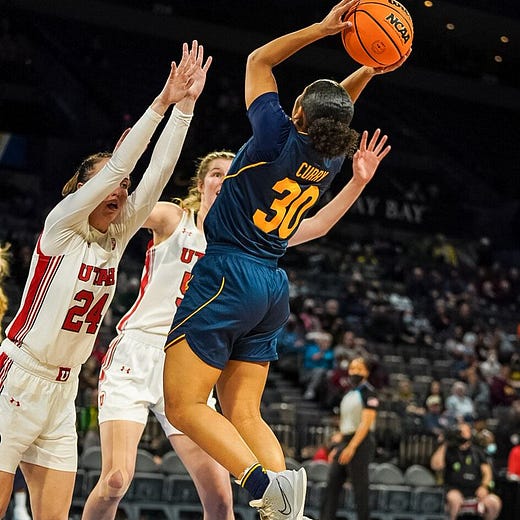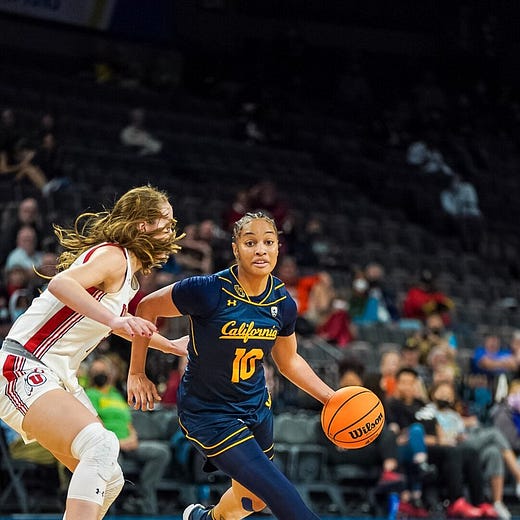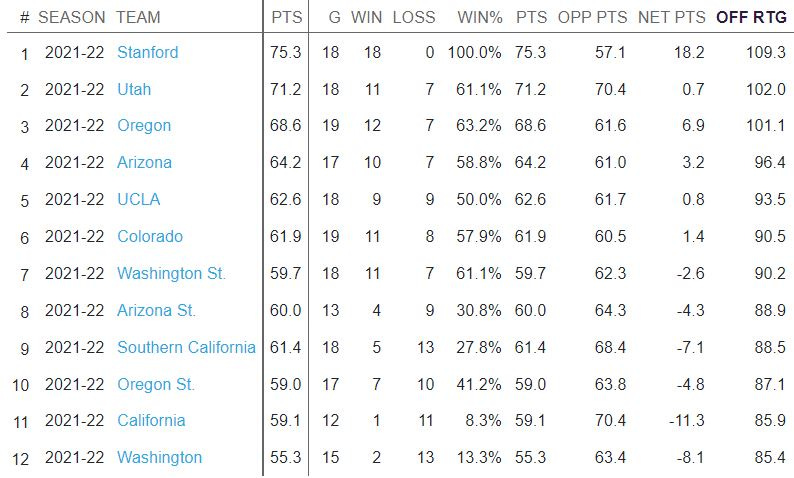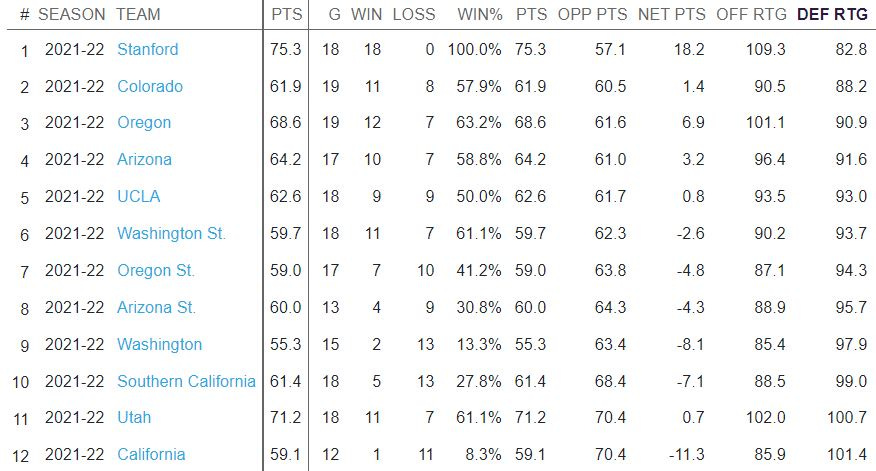Cal WBB season review: Are young Bears poised for 2023 breakthrough?
With everybody back after a rebuilding year, what will it take for Cal to put all the pieces together?
A lead guard scorer who can hit a shot from anywhere on the court, forces the defense to account for her on every play, and draws a ton of fouls.
An all-Pac-12 defensive point guard who can nail an open 3 and has a positive assist-to-turnover ratio
A five star sophomore forward who blocks a ton of shots and figured out how to use her footwork and speed to score inside the 2nd half of the season.
An undersized center who nevertheless blocks a ton of shots, pulls down a ton of defensive boards, and scores inside with reasonable efficiency.
An emerging young center who, adjusted for court time, blocks even more shots and rebounds even more shots than Cal’s starting center.
A bevy of 3-and-D shooting guards with various strengths relative to the ‘three’ or the ‘defense’ side of the spectrum.
Plus an incoming 4 star guard (#51 recruit in the country), the possible return of two grad transfers lost to injury, and the possibility that any number of other younger players on the roster develop into contributors.
If you so choose, you can look at all of the individual pieces on the Cal WBB roster and envision a team ready to compete in the Pac-12, and thus challenge for an NCAA tournament spot.
And yet, it’s hard to get past the grim reality of a 1-11 record vs. Pac-12 opponents, and a team efficiency profile that suggests that 1-11 record isn’t entirely unrepresentative of how the team performed.
To be fair, trying to judge Cal’s performance from the stats is challenging; after all, Cal didn’t play a full Pac-12 schedule and some early games were impacted by COVID player absences.
Here’s Cal’s conference ranking in offensive points/100 possessions, with only Pac-12 games included:
And here’s Cal’s defensive points allowed/100 possessions, again Pac-12 games only:
Earlier, during Pac-12 play, I was more concerned about Cal’s defense, but down the stretch Cal’s defense improved a touch while the offense declined. Cal ended up finished 11th in offense and 12th in defense, in both cases in the ball park of a bunch of other teams in the bottom half of the standings, but not particularly near the teams that finished towards the top of the conference . . . and also Stanford is more or less lapping the field on both ends of the court.
But let’s get a little more granular - we know that Cal struggled in Pac-12 play on both offense and defense, but what were Cal’s relative strengths and weaknesses:
Team Strengths
1. Getting to the line and hitting free throws - led by Jayda Curry and supported by a bunch of players who get to the line at a solid rate, Cal did a good job drawing fouls, particularly in Pac-12 play. And as a nice little bonus, the Bears shot free throws excellently this year. 78% for the year was good for 13th in the nation and best in the conference. Among player in the regular rotation there basically isn’t a bad free throw shooter, which is always good and will be particularly useful if/when the Bears are trying to protect a lead late.
2. Forcing turnovers - Cal has a lot of team speed generally, and they often had to play small, and they took advantage by playing pressure defense and getting in passing lanes. Leilani McIntosh, Cailyn Crocker, and Dalayah Daniels all boasted above average steal rates. Cal’s late game press defenses seen late in the year against Washington and WSU were effective tools to help Cal surmount deficits, and I wouldn’t mind seeing the press more frequently next year.
Team Weaknesses
1. Hitting shots - Cal finished last in Pac-12 play in two point shots, and 10th in 3 point shooting percentage . . . but Cal didn’t take 3 point shots very often, so Cal still finished last in the conference in effective field goal percentage.
I’m not particularly qualified to tell you why Cal struggled to create good shooting looks. My perception is that Cal was maybe too focused on trying to create interior looks for their undersized post players and hoping that inside focus would then open things up outside for the guards, rather than instead focusing on trying to create outside looks for Curry and Cal’s other shooters that might then open space up in the middle, but that’s surface level analysis at best. Figuring this one out would require an Xs and Os deep dive.
2. Offensive rebounding - the flip side to the team speed that Cal often brings to the court is an undersized roster that can get beat up on the glass. Cal finished last in the Pac-12 in defensive rebounding percentage; opponents rebounded 37% of their own misses. And unfortunately, I think the value that Cal earned by going small and forcing turnovers was more than given back by allowing 2nd chance points.
Hopes for 2022-23
What needs to happen for the Bears to take a big step forward next season (beyond obvious things like every player taking a developmental leap)? I’ve got a few hopes and dreams:
Get a sophomore efficiency leap from Jayda Curry. Or, alternatively, get the Jayda Curry Cal got in non-conference play against Pac-12 opponents. At the end of Pac-12 play, Jayda Curry was shooting 49% on her 2 point shots, 34% from three, and getting to the line a lot. That’s a conference MVP kind of player. Alas, in Pac-12 play her two point shooting fell to 32%, as open shots were much MUCH tougher to find. If, with a year of experience under her belt, Curry can become an efficient volume scorer against Pac-12 defenses, Cal’s offense will be in great shape.
Help Michelle Onyiah learn to defend and rebound without fouling. One potential solution to Cal’s size/defensive rebounding problems? Michelle Onyiah, who came on strong late in the season and averaged a rebound every three minutes on the court. The problem? Onyiah also committed a foul every 5.4 minutes on the court, which equates to a foul out in 27 minutes. Another possible rebounding solution? Get Harvard transfer Jadyn Bush back and healthy.
Lean in to small ball and play full court pressure defense more frequently. Even when Cal plays two true post players (typically 2 out of the 3 of Schipholt, Daniels, and Onyiah), there’s still a ton of speed on the court. And we saw Cal really bother teams with full court pressing defenses that forced a ton of turnovers and got teams sped up. I don’t think this is a solution against everybody (Stanford, for one, tends to eat up pressing teams) but I think there’s the depth and athleticism there to make it a bigger part of Cal’s base defenses.
After the complete injury/COVID disaster that was the 2020-21 season, it was just nice to have Cal WBB back on the court with a viable roster, competing in Pac-12 games. With (we assume) everybody back, the 2022-23 season will be the first season with real expectations in quite some time. Now we just have to wait 8 months to finally see what these Bears might be capable of.







Excellent review. Will Amaya Bonner be ready to contribute right away? I still don't think Cailyn Crocker and Jazzy Green were 100% this past season. Hopefully they are next season. Karisma Ortiz is a bit of an unknown factor. Will Sela Heide contribute or be plagued by injury/recovery?